1993 PONTIAC GRAND-AM warning
[x] Cancel search: warningPage 181 of 306
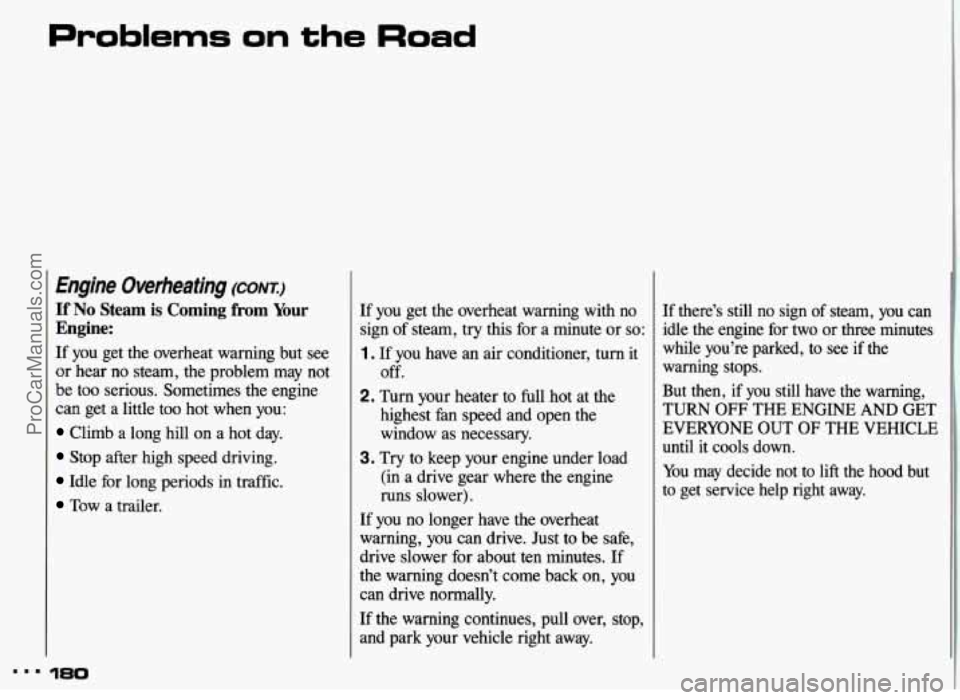
Problems on the Road
Engine Overheating (CONT)
If No Steam is Coming from Your
Engine:
If you get the overheat warning but see
or hear no steam, the problem may not
be
too serious. Sometimes the engine
can get a little too hot when you:
Climb a long hill on a hot day.
Stop after high speed driving.
Idle for long periods in traffic.
Tow a trailer.
180
If you get the overheat warning with no
sign of steam, try this for a minute or so:
1 . If you have an air conditioner, turn it
off.
2. Turn your heater to full hot at the
highest fan speed and open the window as necessary.
3. Try to keep your engine under load
(in a drive gear where the engine
runs slower).
If you no longer have the overheat
warning,
you can drive. Just to be safe,
drive slower for about ten minutes.
If
the warning doesn’t come back on, you
can drive normally.
If the warning continues, pull over, stop,
and park your vehicle right away. If there’s
still no sign of steam, you can
idle the engine for two or three minutes
while you’re parked, to
see if the
warning stops.
But then, if you still have the warning,
TURN
OFF THE ENGINE AND GET
EVERYONE OUT
OF THE VEHICLE
until it cools down.
You may decide not to lift the hood but
to get service help right away.
ProCarManuals.com
Page 183 of 306

Problems on the Road
Engine Overheating (CONTJ
How to Add Coolant to the Coolant
Surge Tank:
If you haven’t found a problem yet, but
the coolant level isn’t at or above
FULL
COLD, add a 50/50 mixture of clean
water
(preferably distilled) and a proper
antifreeze at the coolant surge
tank, but
be sure the cooling system, including
the coolant surge
tank pressure cap, is
cool before
you do it. (See the Index
under Engine Coolant for more
information about the proper coolant
mix.)
182
L Steam and scalding liquids
L from a hot cooling system can
blow out and burn you badly. They
are under pressure, and if you turn
cap-evm a little-they can come
out at high speed. Never turn the
pressure cap when the cooliag
tank pressure cap, is hot. Wait for
the cooling system and coolant
you ever have to turn the pmsure
MP.
the coolant surge tank pressure
system, including the COoIant surge
surge tank pressure cap to cool if
Adding only plain water to
dangerous. Plain water, or some
other liquid like alcohol, can boil
before the proper coolant mix will.
Your vehicle’s coolant warning
system is set for the proper coolant
mix. With plain water or the
wrong mix, your engine could get
too hot but you wouldn’t get the overheat warning. Your engine
could catch fire and you or others
could be burned. Use a
50/50 mix
of
clean water and a proper
antifreeze.
k your cooling system can be I
ProCarManuals.com
Page 187 of 306
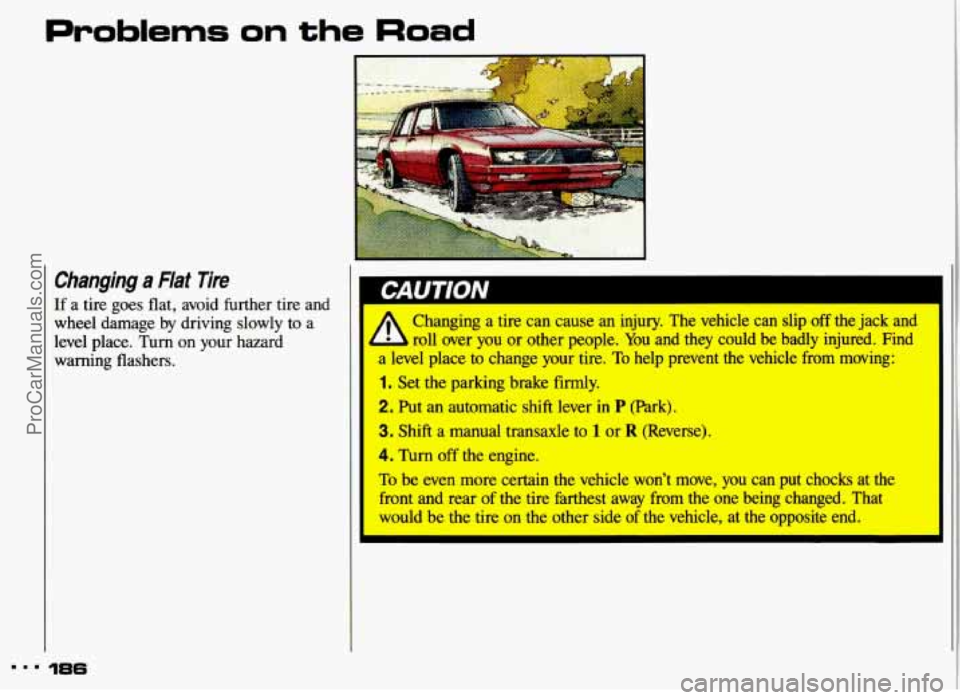
Problems on the Road
Changing a Flat lire
If a tire goes flat, avoid further tire and
wheel damage by driving slowly to a
level place. Turn
on your hazard
warning flashers.
186
IUII
Changing a tire can cause an injury. The vehicle can slip off the jack and
roll over you or other people. You and they could be badly injured. Find I
a level place to change your tire. To help prevent the vehicle from moving:
1. Set the parking brake firmly.
2. Put an automatic shift lever in P Wk). I
3. Shift a manual transaxle to 1 or R (Reverse).
4. Turn off the engine.
To be even more certain the vehicle won't move, you can put chocks at the
front and fear of the tire farthest away from the one being changed. That
would be the tire on the other side of the vehicle, at the opposite end.
ProCarManuals.com
Page 193 of 306
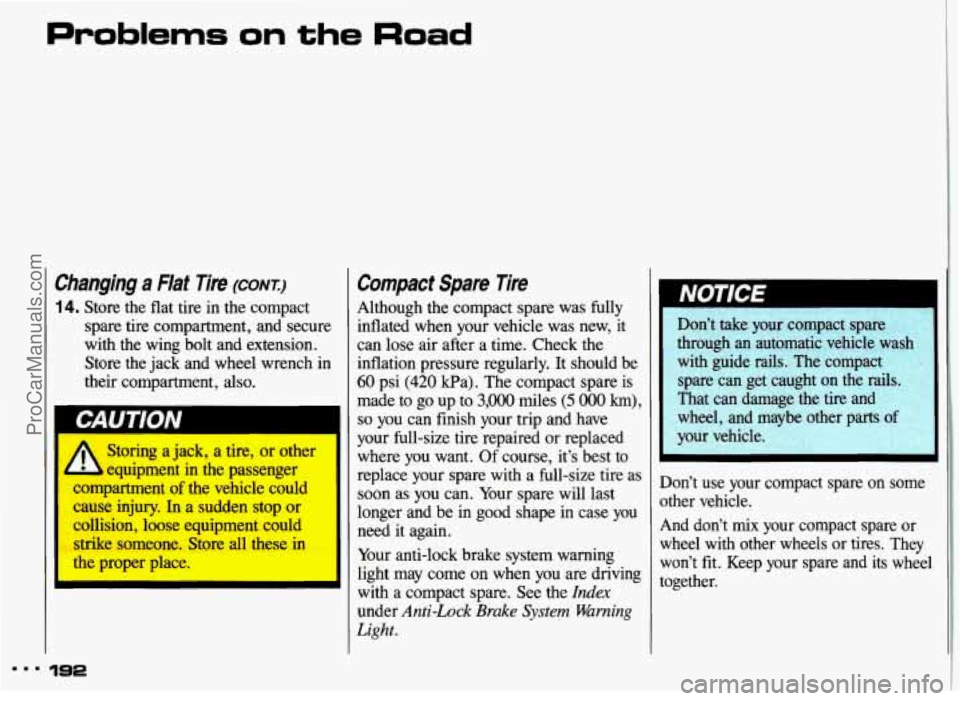
Changing a Flat Tire (corvr)
14. Store the flat tire in the compact
spare
tire compartment, and secure
with the
wing bolt and extension.
Store the jack and wheel wrench in
their compartment, also.
I A Storing a jack, a tire, or other
- equipment in the passenger
ompartment
of the vehicle could I
cause injury. In a sudden stop or
collision, loose equipment could strike someone. Store all these in
the proper place.
i
Compact Spare Tire
Although the compact spare was fully
inflated when your vehicle was new, it can lose air after a time. Check the
inflation pressure regularly. It should be
60 psi (420 Wa). The compact spare is
made to go up to
3,000 miles (5 O00 km),
so you can finish your trip and have
your full-size tire repaired or replaced
where you want.
Of course, it’s best to
replace your spare with a full-size tire as
soon
as you can. Your spare will last
longer and be in good shape
in case you
need it again.
Your anti-lock brake system warning
light may come on when you are driving
with a compact spare. See the
Idex
under Anti-Lock Brake System Warning
Light.
192
Don’t take your compact spare
through
an automatic vehicle wash I
with guide rails. The compact spare can get caught on the rails.
That can damage the tire and
wheel, and maybe other parts
of
your vehicle.
)on? use your compact spare on some
)ther vehicle.
ind don’t
mix your compact spare or
vheel with other wheels or tires. They
von’t
fit. Keep your spare and its wheel
ogether.
ProCarManuals.com
Page 222 of 306

Engine Coolant
The following explains your cooling system and how to add coolant when it
is low. If you have a problem with
engine overheating, see the
Index under
Engine Overheating.
The proper coolant for your Pontiac
will:
Give freezing protection down to
Give boiling protection up to 262°F
Protect against rust and corrosion.
Help keep the proper engine
-34°F (-37°C).
(128°C).
temperature.
Let the warning
should. lights work as they
What to Use:
Use
a mixture of one-half clean water
(preferably distilled) and one-half
antifreeze that meets
“GM Specification
1825-M,” which won’t damage
aluminum parts. You can
also use a
recycled coolant conforming to GM
Specification 1825-M with a complete
coolant flush and refill. If you use this
mixture, you don’t need to add anything
else.
CAUTION I
A Adding only plain water ta
L pur cooling system can be
dangerous. Plain water, or some
other liquid like alcohol, can boil
bebe the proper coolant mix will.
system is set for the proper coolant
mix. With plain water or the
wrong mix, your engine could get
too hot but you wouldn’t get the
overheat warning, Your engine
could catch fire and you or others
could be burned. Use a 50/50 mix
of clean water and a proper
antifreeze.
Your v&hicle’s coolant warning
221 .
ProCarManuals.com
Page 227 of 306
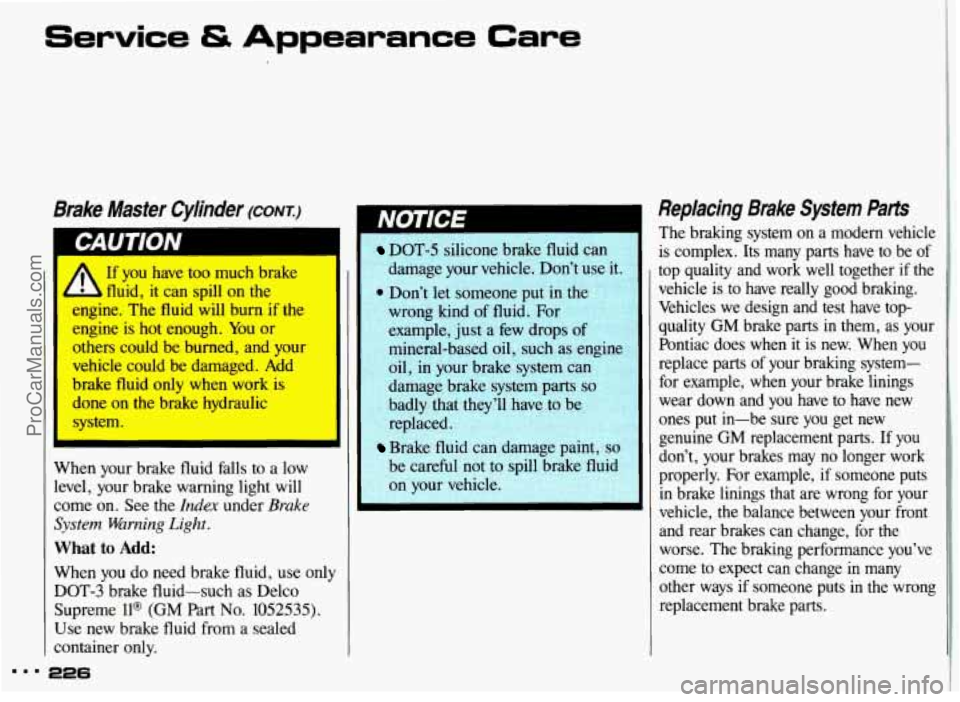
Service fS Appearance Care
Brake Master Cylinder (CONI)
I If you have too much brake
fluid, it can spill
on the
engine. The fluid will burn
if the
engine
is hot enough. You or
others could be burned, and your
vehicle could
be damaged. Add
brake fluid only when work is
done on the brake hydraulic
system.
When your brake fluid falls to a low
level, your brake warning light will
come on. See the
Index under Brake
System Warning Light.
What to Add:
When you do need brake fluid, use only
DOT-3 brake fluid-such as Delco
Supreme
ll@ (GM Part No. 1052535).
Use new brake fluid from a sealed
container only.
I DOT-5 silicone brake fluid can
;'Don't let someone put in the
:> 1 I :, !wrong i kind of fluid. For
example, just a few drops of
I , mineral-based oil, such as engine
-.?,'oil, in your brake system can
damage brake system parts
so
damage your vehicle. Don't use it.
". ,
I : '
" 1. , badly that they
; -qeplaced. %>, , .
Brake fluid can damage paint, so
be careful not to spill brake fluid
on your vehicle.
-
Replacing Brake System Parts
The braking system on a modern vehicle
is complex. Its many parts have to be of
top quality and work well together
if the
vehicle is to have really good braking.
Vehicles we design and test have top-
quality
GM brake parts in them, as your
Pontiac does when
it is new. When you
replace parts of your bralung system-
for example, when your brake linings
wear down and you have to have new
ones put in-be sure you get new
genuine
GM replacement parts. If you
don't, your brakes may no longer work
properly. For example,
if someone puts
in brake linings that are wrong for your
vehicle, the balance between your front
and rear brakes can change, for the
worse. The braking performance you've
come to expect can change
in many
other ways
if someone puts in the wrong
replacement brake parts.
m.. 226
ProCarManuals.com
Page 237 of 306
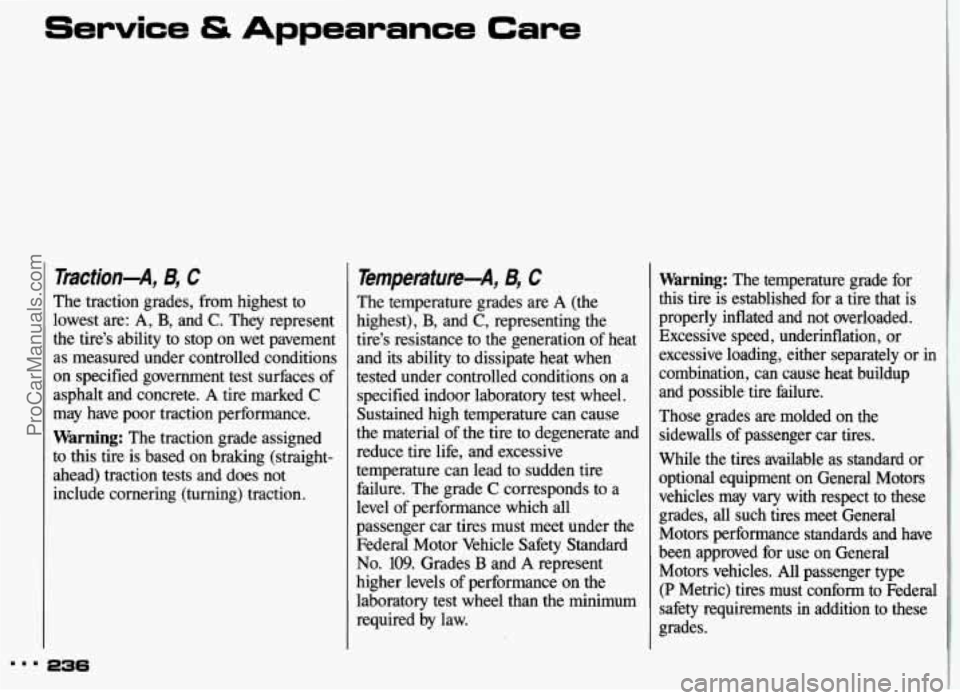
Traction-A, B, C
The traction grades, from highest to
lowest are:
A, B, and C. They represent
the tire’s ability to stop on wet pavement
as measured under controlled conditions
on specified government test surfaces of
asphalt and concrete.
A tire marked C
may have poor traction performance.
Warning: The traction grade assigned
to this tire is based on braking (straight-
ahead) traction tests and does not
include cornering (turning) traction.
Temperature-A, B, C
The temperature grades are A (the
highest),
B, and C, representing the
tire’s resistance to the generation of heat
and its ability to dissipate heat when
tested under controlled conditions on a
specified indoor laboratory test wheel.
Sustained high temperature can cause
the material of the tire to degenerate and
reduce tire life, and excessive
temperature can lead to sudden tire
failure. The grade
C corresponds to a
level of performance which all
passenger car tires must meet under the
Federal Motor Vehicle Safety Standard
No. 109. Grades B and A represent
higher levels of performance on the
laboratory test wheel than the minimum required by law.
Warning: The temperature grade for
this tire is established for a tire that is
properly inflated and not overloaded. Excessive speed, underinflation, or
excessive loading, either separately or in
combination, can cause heat buildup
and possible tire failure.
Those grades are molded on the sidewalls of passenger car tires.
While the tires available as standard or
optional equipment on General Motors
vehicles may vary with respect to these
grades,
all such tires meet General
Motors performance standards and have
been approved for use on General Motors vehicles. All passenger type
(P Metric) tires must conform to Federal
safety requirements in addition to these
grades.
ProCarManuals.com
Page 276 of 306

Section C: Periodic Maintenance Inspections
Listed below are inspections and services which should be perfo\
rmed at least twice a year (for instance, each spring and fall).
You should let your GM dealer’s service department or other qualified service center do these jobs: Make sure any necessary
repairs are completed at once.
L
INSPECTION
OR SERVICE
Steering, Suspension
and Front-Wheel-Drive
Axle Boot and Seal
Inspection
Exhaust System
Inspection
Throttle Linkage
Inspection
Brake System
Inspection
WHAT SHOULD BE DONE I
Inspect the front and rear suspension and steering system for \
damaged, loose or missing parts,
signs
of wear, or lack of lubrication. Inspect the power steering lines and hoses for proper
hookup, binding, leaks, cracks, chafing, etc. Clean and then in\
spect the drive axle boot seals for damage, tears or leakage. Replace seals if necessary.
Inspect the complete exhaust system. Inspect the body near the \
exhaust system. Look for broken,
damaged, missing or out-of-position parts
as well as open seams, holes, loose connections, or
other conditions which could cause a heat build-up in the floor pan or could let exhaust fumes
into the vehicle. See the
Idex under EnRine Exhaust.
Inspect the throttle linkage for interference or binding, and for damaged or missing parts.
Replace parts as needed.
Inspect the complete system. Inspect brake lines and hoses for \
proper hookup, binding, leaks,
cracks, chafing, etc. Inspect disc brake pads for wear and rot\
ors for surface condition. Also
inspect drum brake linings for wear and cracks. Inspect other brake parts, including drums,
wheel cylinders, calipers, parking brake, etc. The parking brake is self-adjusting and no manual
adjustment is required,
You may need to have your brakes inspected more often if your driving
habits or conditions result in frequent braking.
NOTE:
A low brake fluid level can indicate worn disc brake pads which \
may need to be
serviced. Also, if the brake system warning light stays on or comes on, something may be wrong
with the brake system. See the
Index under Brake System Warning Light. If your anti-lock brake
system warning light stays on, comes on or flashes, something may be wrong with the anti-lock
brake system. See the
Index under Anti-Lock Brake System Warning Light.
275
ProCarManuals.com